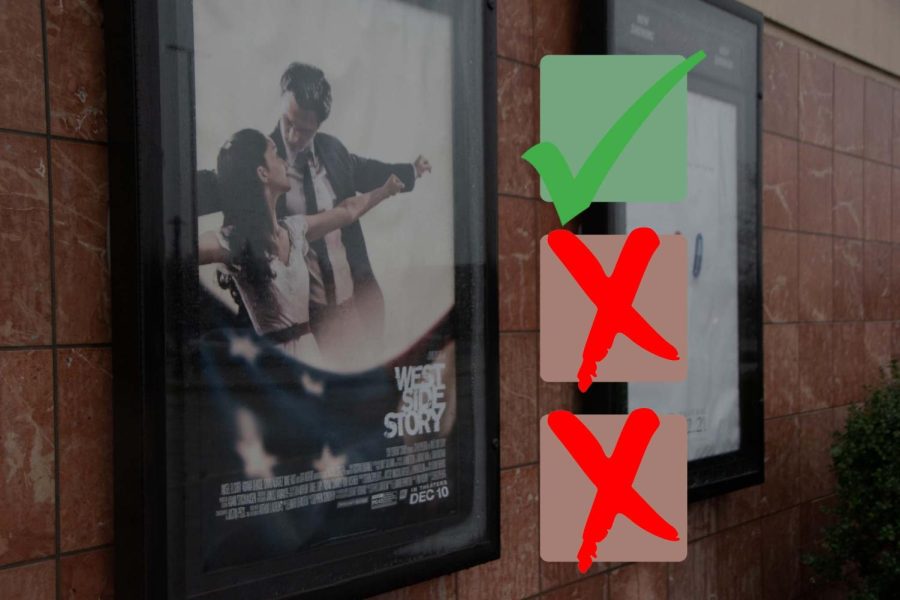Behind the Bechdel Test: Does It Still Matter?
Many popular movies do not pass the Bechdel test, including “Harry Potter: The Order of the Phoenix” and “West Side Story.”
January 26, 2022
The Bechdel test measures certain aspects of female representation. If a film cannot meet the basic requirements of this test — which feel like a bare minimum — then it isn’t a good movie, right?
Wrong.
Before looking at the different ways that films pass or fail the Bechdel test, it’s important to examine the criteria used by this test.
To pass the Bechdel test, a movie must follow three rules that are supposed to show if the story has a good representation of women. First, the film must have at least two female characters. Second, the women must talk to each other. Third, that conversation must be about something other than a man. Another rule, that is sometimes included, is that both women must have names.
The Bechdel test is a little vague and it doesn’t really take into account the types of characters speaking. If it fulfills the three basic rules then it passes, therefore it fails to look beyond the test and take into account the context of the movies or the characters.
The test was coined by Alison Bechdel in one of her comic strips, “The Rule.” The strip features two women talking about if a movie is worth seeing by introducing the rules.
To fit the bill, the women in these movies don’t necessarily have to be main characters and they don’t have to be essential to the plot. The conversations that happen can also be mundane and have no purpose or significance to the rest of the movies.
With only three guidelines, the Bechdel test fails to accurately define good female representation. One example is in “Lord of the Rings: The Two Towers,” which is a movie that passes the test. The rest of the movies in the trilogy fail even though they have strong female characters present such as Eowyn and Arwen.
“The Two Towers” can be considered passing all three tests, but the conversation that takes place is a short one between Eowyn and a little girl, Freda, about her mother. It is a conversation between two named characters and it doesn’t involve a man, but the conversation is short and Freda isn’t a big part of the story.
Another drawback of the Bechdel test is that the website where you can view movies that pass or fail can be edited by anyone. It comes down to people who have viewed the movie and decided what meets the requirements. This means what passes or fails isn’t really set in stone because it can be up to the viewer’s interpretation.
That doesn’t mean the test is all bad though. It’s important that movies have a guideline to follow so they can
Knowing if a movie passes the Bechdel test before watching it can be useful, but it should be up to the viewers of movies to decide whether or not the women they saw were well-represented.
A few movies that passed the Bechdel test I enjoyed are; “Bend it Like Beckham” (2002), “Hidden Figures” (2016), “Jaws” (1975), and “Kill Bill Vol. 1” (2003).
“Bend it Like Beckham” features an 18-year-old Indian woman in England as the main character. It has good representation because it shows the clash between cultures and it features her trying to break into soccer, a very male-dominated atmosphere. It shows the struggles women go through to break into sports and how women play different roles in different cultures.
Similarly, “Hidden Figures” and “Kill Bill Vol.1” were both female-led. Both highlighted the variety of struggles women go through, and “Hidden Figures” emphasized what women of color have to deal with on top of that.
“Jaws” wasn’t female-led, but I enjoyed the movie and I like how they found a way to give the women in the film identities, even if they aren’t considered main characters.
These movies are in very different genres but they all find a way to pass the test. One big thing I found though was that a lot of the movies that passed the test had a woman as the main character. It was nice to see “Jaws” pass because it shows how easy it is to incorporate women having conversations that don’t revolve around men in a movie where a woman isn’t considered a main character.
However, some popular movies that didn’t pass the test, such as “The Grand Budapest Hotel” (2014), “The Avengers” (2013), “Avatar” (2009), and “The Imitation Game” (2014).
These movies are still great movies, it’s just a little disappointing that they weren’t able to give their female characters conversations that aren’t about men. The majority of these movies have at least one named female character, but for some reason, they are unable to converse or unable to have that conversation about something other than a man.
The Bechdel test does have flaws, but I think it is useful. It’s important to have a way to see the representation of women on screen. I think a more extensive version would be better, but the system is still important and can be helpful.





